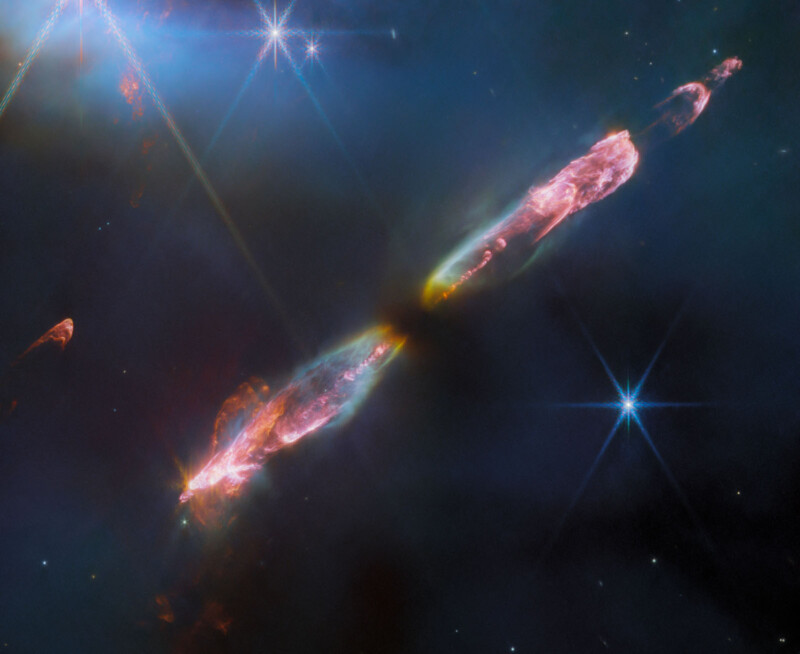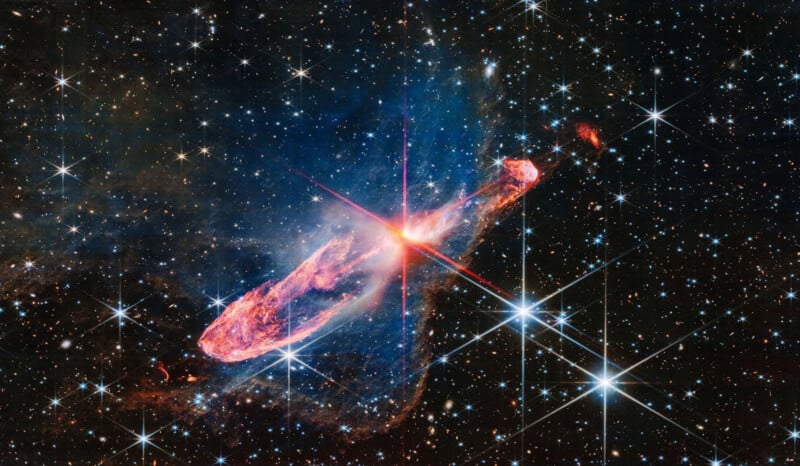Webb Telescope Photo Shows What Our Baby Sun Looked Like

The James Webb Space Telescope (JWST) has captured an image of Herbig-Haro 211 that is an “infantile analog” of the Sun when it was just a baby star with a mass of about one-twelfth the present-day Sun.
Herbig-Haro (HH) objects are “luminous regions surrounding newborn stars, formed when stellar winds or jets of gas spewing from these newborn stars form shock waves colliding with nearby gas and dust at high speeds,” explains NASA. HH 211 showcases an outflow from a Class 0 protostar.
Herbig-Haro 211 is located about 1,000 light-years away in the constellation Perseus. The Class 0 protostar in the center will one day grow into a star like the Sun. Scientists believe the image here could represent what the Sun looked like when it was “no more than a few tens of thousands of years old.” The Sun is about 4.6 billion years old today.
This beautiful image was captured by Webb’s Near Infrared Camera (NIRCam). Infrared imaging technology is especially powerful when looking at newborn stars and their outflows because they are formed within the gas of a molecular cloud, which is difficult to see through in visible light. HH 211 emits infrared light, which can penetrate through the gas and dust that blocks the object from view.
“Molecules excited by the turbulent conditions, including molecular hydrogen, carbon monoxide, and silicon monoxide, emit infrared light that Webb can collect to map out the structure of the outflows,” says NASA.
The new image shows a series of “bow shocks” in the lower-left and top-right corners. Between the two bow shocks is a narrow bipolar jet that powers these shocks.
HH 211 has been imaged before, but Webb’s incredible resolution offers an unprecedented look at the object. NASA says the new JWST image delivers five to 10 times higher spatial resolution than any prior images of HH 211.
With such extreme detail available to scientists, they have determined that the inner jet has mirror symmetry on either side of the central protostar, which lends credence to the preexisting notion that the protostar “may in fact be an unresolved binary star.”
“Earlier observations of HH 211 with ground-based telescopes revealed giant bow shocks moving away from us (northwest) and moving towards us (southeast) and cavity-like structures in shocked hydrogen and carbon monoxide respectively, as well as a knotty and wiggling bipolar jet in silicon monoxide. Researchers have used Webb’s new observations to determine that the object’s outflow is relatively slow in comparison to more evolved protostars with similar types of outflows,” NASA explains.

Researchers have determined that the velocities of the innermost outflow seem to be at about 48 to 60 miles per second (80 to 100 kilometers per second). To put that speed into perspective, the higher end of that range is 216,000 miles per hour.
“However, the difference in velocity between these sections of the outflow and the leading material they’re colliding with — the shockwave — is much smaller. The researchers concluded that outflows from the youngest stars, like that in the center of HH 211, are mostly made up of molecules, because the comparatively low shock wave velocities are not energetic enough to break the molecules apart into simpler atoms and ions,” NASA concludes.